Improvement in NO2 Gas Sensing Properties of Semiconductor-Type Sensors by Loading Pt into BiVO4 Nanocomposites at Room Temperature
Abstract
:1. Introduction
2. Materials and Methods
2.1. Materials
2.2. Preparation of Bismuth Vanadate
2.3. Synthesis Method for Pt/BiVO4 Nanocomposite
2.4. Characterization
2.5. Sensor Fabrication and Measurements
3. Results and Discussion
3.1. Structure Property
3.2. Gas-Sensing Performance of Pt/BiVO4
3.3. Underlying Sensing Mechanism
4. Conclusions
Author Contributions
Funding
Institutional Review Board Statement
Informed Consent Statement
Data Availability Statement
Acknowledgments
Conflicts of Interest
References
- Lim, S.H.; Feng, L.; Kemling, J.W.; Musto, C.J.; Suslick, K.S. An optoelectronic nose for the detection of toxic gases. Nat. Chem. 2009, 1, 562–567. [Google Scholar] [CrossRef] [Green Version]
- Kampa, M.; Castanas, E. Human health effects of air pollution. Environ. Pollut. 2008, 151, 362–367. [Google Scholar] [CrossRef]
- Zhu, Z.; Lin, S.-J.; Wu, C.-H.; Wu, R.-J. Synthesis of TiO2 nanowires for rapid NO2 detection. Sens. Actuator A Phys. 2018, 272, 288–294. [Google Scholar] [CrossRef]
- Zhang, W.; Hu, M.; Liu, X.; Wei, Y.; Li, N.; Qin, Y. Synthesis of the cactus-like silicon nanowires/tungsten oxide nanowires composite for room-temperature NO2 gas sensor. J. Alloys Compd. 2016, 679, 391–399. [Google Scholar] [CrossRef]
- Liu, Y.; Gao, X.; Li, F.; Lu, G.; Zhang, T.; Barsan, N. Pt-In2O3 mesoporous nanofibers with enhanced gas-sensing performance towards ppb-level NO2 at room temperature. Sens. Actuator B Chem. 2018, 260, 927–936. [Google Scholar] [CrossRef]
- Sharma, B.; Sharma, A.; Myung, J.-h. Selective ppb-level NO2 gas sensor based on SnO2-boron nitride nanotubes. Sens. Actuator B Chem. 2021, 331, 129464. [Google Scholar] [CrossRef]
- Bai, S.; Zhang, K.; Zhao, Y.; Li, Q.; Luo, R.; Li, D.; Chen, A. rGO decorated NiO-BiVO4 heterojunction for detection of NO2 at low temperature. Sens. Actuator B Chem. 2021, 329, 128912. [Google Scholar] [CrossRef]
- Choi, S.W.; Katoch, A.; Sun, G.J.; Kim, S.S. Bimetallic Pd/Pt nanoparticle-functionalized SnO2 nanowires for fast response and recovery to NO2. Sens. Actuator B Chem. 2013, 181, 446–453. [Google Scholar] [CrossRef]
- Li, Q.; Han, N.; Zhang, K.; Bai, S.; Guo, J.; Luo, R.; Li, D.; Chen, A. Novel p-n heterojunction of BiVO4/Cu2O decorated with rGO for low concentration of NO2 detection. Sens. Actuator B Chem. 2020, 320, 128284. [Google Scholar] [CrossRef]
- Bai, S.; Tian, K.; Fu, H.; Feng, Y.; Luo, R.; Li, D.; Chen, A.; Liu, C.C. Novel α-Fe2O3/BiVO4 heterojunctions for enhancing NO2 sensing properties. Sens. Actuator B Chem. 2018, 268, 136–143. [Google Scholar] [CrossRef]
- Zhu, Z.; Lin, Y.-C.; Chung, C.-L.; Wu, R.-J.; Huang, C.-L. A novel composite of triangular silver nanoplates on BiVO4 for gaseous formaldehyde degradation. Appl. Surf. Sci. 2021, 543, 148784. [Google Scholar] [CrossRef]
- Yang, J.; Shi, Q.; Zhang, R.; Xie, M.; Jiang, X.; Wang, F.; Cheng, X.; Han, W. BiVO4 quantum tubes loaded on reduced graphene oxide aerogel as an efficient photocatalyst for gaseous formaldehyde degradation. Carbon 2018, 138, 118–124. [Google Scholar] [CrossRef]
- Qiao, X.; Xu, Y.; Yang, K.; Ma, J.; Li, C.; Wang, H.; Jia, L. Mo doped BiVO4 gas sensor with high sensitivity and selectivity towards H2S. Chem. Eng. J. 2020, 395, 125144. [Google Scholar] [CrossRef]
- Li, C.; Qiao, X.; Jian, J.; Feng, F.; Wang, H.; Jia, L. Ordered porous BiVO4 based gas sensors with high selectivity and fast-response towards H2S. Chem. Eng. J. 2019, 375, 121924. [Google Scholar] [CrossRef]
- Li, F.; Leung, D.Y.C. Highly enhanced performance of heterojunction Bi2S3/BiVO4 photoanode for photoelectrocatalytic hydrogen production under solar light irradiation. Chem. Eng. Sci. 2020, 211, 115266. [Google Scholar] [CrossRef]
- Li, F.; Zhao, W.; Leung, D.Y.C. Enhanced photoelectrocatalytic hydrogen production via Bi/BiVO4 photoanode under visible light irradiation. Appl. Catal. B Environ. 2019, 258, 117954. [Google Scholar] [CrossRef]
- Chen, L.; Zhang, M.; Yang, J.; Li, Y.; Sivalingam, Y.; Shi, Q.; Xie, M.; Han, W. Synthesis of BiVO4 quantum dots/reduced graphene oxide composites for CO2 reduction. Mater. Sci. Semicond. Process. 2019, 102, 104578. [Google Scholar] [CrossRef]
- Li, X.; Wei, D.; Ye, L.; Li, Z. Fabrication of Cu2O-RGO/BiVO4 nanocomposite for simultaneous photocatalytic CO2 reduction and benzyl alcohol oxidation under visible light. Inorg. Chem. Commun. 2019, 104, 171–177. [Google Scholar] [CrossRef]
- Talasila, G.; Sachdev, S.; Srivastava, U.; Saxena, D.; Ramakumar, S.S.V. Modified synthesis of BiVO4 and effect of doping (Mo or W) on its photoelectrochemical performance for water splitting. Energy Rep. 2020, 6, 1963–1972. [Google Scholar] [CrossRef]
- Luo, J.; Fu, P.; Qu, Y.; Lin, Z.; Zeng, W. The n-butanol gas-sensing properties of monoclinic scheelite BiVO4 nanoplates. Phys. E 2018, 103, 71–75. [Google Scholar] [CrossRef]
- Lin, Y.; Cai, H.; Chen, H.; Luo, H. One–pot synthesis of Bi4V2O11/BiVO4 heterostructure with enhanced photocatalytic activity for dye degradation. Appl. Surf. Sci. 2021, 544, 148921. [Google Scholar] [CrossRef]
- Malathi, A.; Madhavan, J.; Ashokkumar, M.; Prabhakarn, A. A review on BiVO4 photocatalyst: Activity enhancement methods for solar photocatalytic applications. Appl. Catal. 2018, 555, 47–74. [Google Scholar]
- Abdi, F.F.; Savenije, T.J.; May, M.M.; Dam, B.; van de Krol, R. The origin of slow carrier transport in BiVO4 thin film photoanodes: A time-resolved microwave conductivity study. J. Phys. Chem. Lett. 2013, 4, 2752–2757. [Google Scholar] [CrossRef]
- Zhou, B.; Zhao, X.; Liu, H.; Qu, J.; Huang, C.P. Visible-light sensitive cobalt-doped BiVO4 (Co-BiVO4) photocatalytic composites for the degradation of methylene blue dye in dilute aqueous solutions. Appl. Catal. B Environ. 2010, 99, 214–221. [Google Scholar] [CrossRef]
- Wang, M.; Guo, P.; Chai, T.; Xie, Y.; Han, J.; You, M.; Wang, Y.; Zhu, T. Effects of Cu dopants on the structures and photocatalytic performance of cocoon-like Cu-BiVO4 prepared via ethylene glycol solvothermal method. J. Alloys Compd. 2017, 691, 8–14. [Google Scholar] [CrossRef]
- Mohamed, R.M.; Mkhalid, I.A.; Shawky, A. Facile synthesis of Pt–In2O3/BiVO4 nanospheres with improved visible-light photocatalytic activity. J. Alloys Compd. 2019, 775, 542–548. [Google Scholar] [CrossRef]
- Cao, S.-W.; Yin, Z.; Barber, J.; Boey, F.Y.C.; Loo, S.C.J.; Xue, C. Preparation of Au-BiVO4 Heterogeneous Nanostructures as Highly Efficient Visible-Light Photocatalysts. ACS Appl. Mater. Interfaces 2012, 4, 418–423. [Google Scholar] [CrossRef] [PubMed]
- Wang, M.; Han, J.; Lv, C.; Zhang, Y.; You, M.; Liu, T.; Li, S.; Zhu, T. Ag, B, and Eu tri-modified BiVO4 photocatalysts with enhanced photocatalytic performance under visible-light irradiation. J. Alloys Compd. 2018, 753, 465–474. [Google Scholar] [CrossRef]
- Wang, W.; Wang, J.; Wang, Z.; Wei, X.; Liu, L.; Ren, Q.; Gao, W.; Liang, Y.; Shi, H. p–n junction CuO/BiVO4 heterogeneous nanostructures: Synthesis and highly efficient visible-light photocatalytic performance. Dalton Trans. 2014, 43, 6735–6743. [Google Scholar] [CrossRef] [PubMed]
- Fujimoto, I.; Wang, N.; Saito, R.; Miseki, Y.; Gunji, T.; Sayama, K. WO3/BiVO4 composite photoelectrode prepared by the improved auto-combustion method for highly efficient water splitting. Int. J. Hydrogen Energy 2014, 39, 2454–2461. [Google Scholar] [CrossRef]
- Samerjai, T.; Tamaekong, N.; Liewhiran, C.; Wisitsoraat, A.; Phanichphant, S. NO2 gas sensing of flame-made Pt-loaded WO3 thick films. J. Solid State Chem. 2014, 214, 47–52. [Google Scholar] [CrossRef]
- Mirzaei, A.; Bang, J.H.; Choi, M.S.; Han, S.; Lee, H.Y.; Kim, S.S.; Kim, H.W. Changes in characteristics of Pt-functionalized RGO nanocomposites by electron beam irradiation for room temperature NO2 sensing. Ceram. Int. 2020, 46, 21638–21646. [Google Scholar] [CrossRef]
- Wang, C.-Y.; Hong, Z.-S.; Wu, R.-J. Promotion effect of Pt on a SnO2–WO3 material for NOx sensing. Phys. E 2015, 69, 191–197. [Google Scholar] [CrossRef]
- Bai, S.; Li, Q.; Han, N.; Zhang, K.; Tang, P.; Feng, Y.; Luo, R.; Li, D.; Chen, A. Synthesis of novel BiVO4/Cu2O heterojunctions for improving BiVO4 towards NO2 sensing properties. J. Colloid Interface Sci. 2020, 567, 37–44. [Google Scholar] [CrossRef]
- Liu, H.; Xu, Y.; Zhang, X.; Zhao, W.; Ming, A.; Wei, F. Enhanced NO2 sensing properties of Pt/WO3 films grown by glancing angle deposition. Ceram. Int. 2020, 46, 21388–21394. [Google Scholar] [CrossRef]
- He, H.; Zhou, Y.; Ke, G.; Zhong, X.; Yang, M.; Bian, L.; Lv, K.; Dong, F. Improved Surface Charge Transfer in MoO3/BiVO4 Heterojunction Film for Photoelectrochemical Water Oxidation. Electrochim. Acta 2017, 257, 181–191. [Google Scholar] [CrossRef]
- Zhang, C.; Luo, Y.; Xu, J.; Debliquy, M. Room temperature conductive type metal oxide semiconductor gas sensors for NO2 detection. Sens. Actuators A Phys. 2019, 289, 118–133. [Google Scholar] [CrossRef]
- Cabot, A.; Arbiol, J.; Morante, J.R.; Weimar, U.; Bârsan, N.; Göpel, W. Analysis of the noble metal catalytic additives introduced by impregnation of as obtained SnO2 sol-gel nanocrystals for gas sensors. Sens. Actuator B Chem. 2000, 70, 87–100. [Google Scholar] [CrossRef]
- Bang, J.H.; Mirzaei, A.; Han, S.; Lee, H.Y.; Shin, K.Y.; Kim, S.S.; Kim, H.W. Realization of low-temperature and selective NO2 sensing of SnO2 nanowires via synergistic effects of Pt decoration and Bi2O3 branching. Ceram. Int. 2021, 47, 5099–5111. [Google Scholar] [CrossRef]
- Lu, Y.; Jing, H.; Yu, H.; Zhao, Y.; Li, Y.; Huo, M. Enhanced catalytic performance of BiVO4/Pt under the combination of visible-light illumination and ultrasound waves. J. Taiwan Inst. Chem. E 2019, 102, 133–142. [Google Scholar] [CrossRef]
- Zhang, Q.; Wang, T.; Sun, Z.; Xi, L.; Xu, L. Performance improvement of photoelectrochemical NO2 gas sensing at room temperature by BiVO4-polyoxometalate nanocomposite photoanode. Sens. Actuator B Chem. 2018, 272, 289–295. [Google Scholar] [CrossRef]
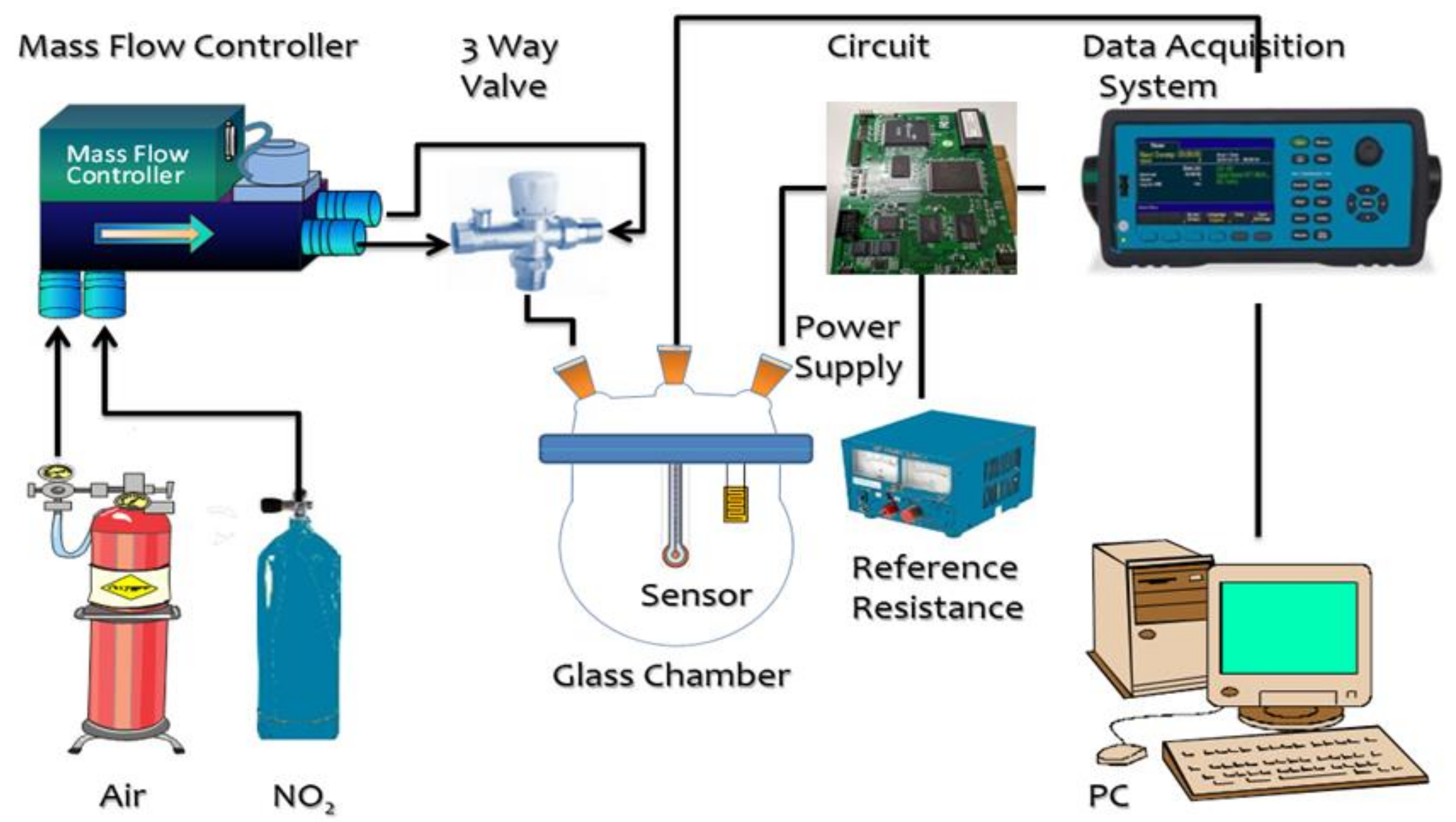
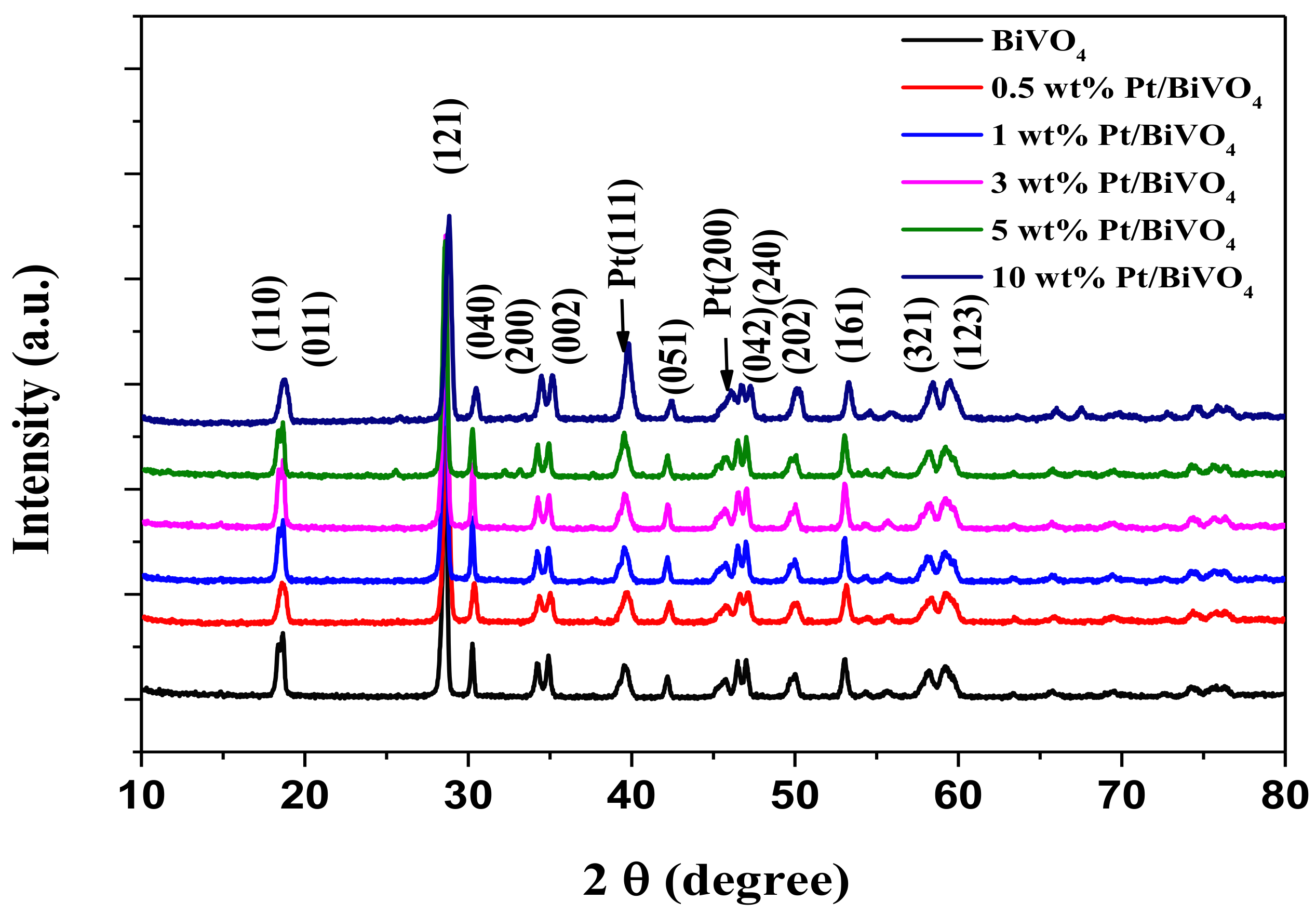

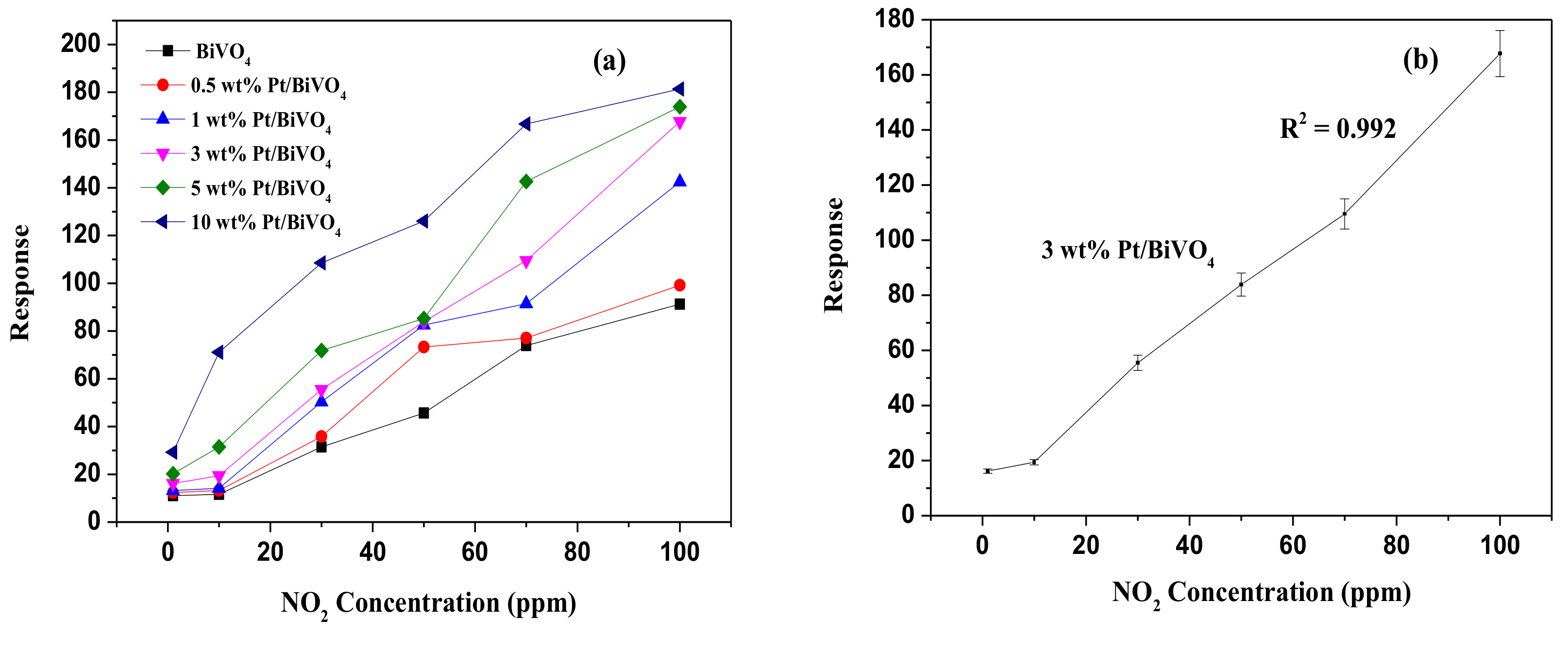
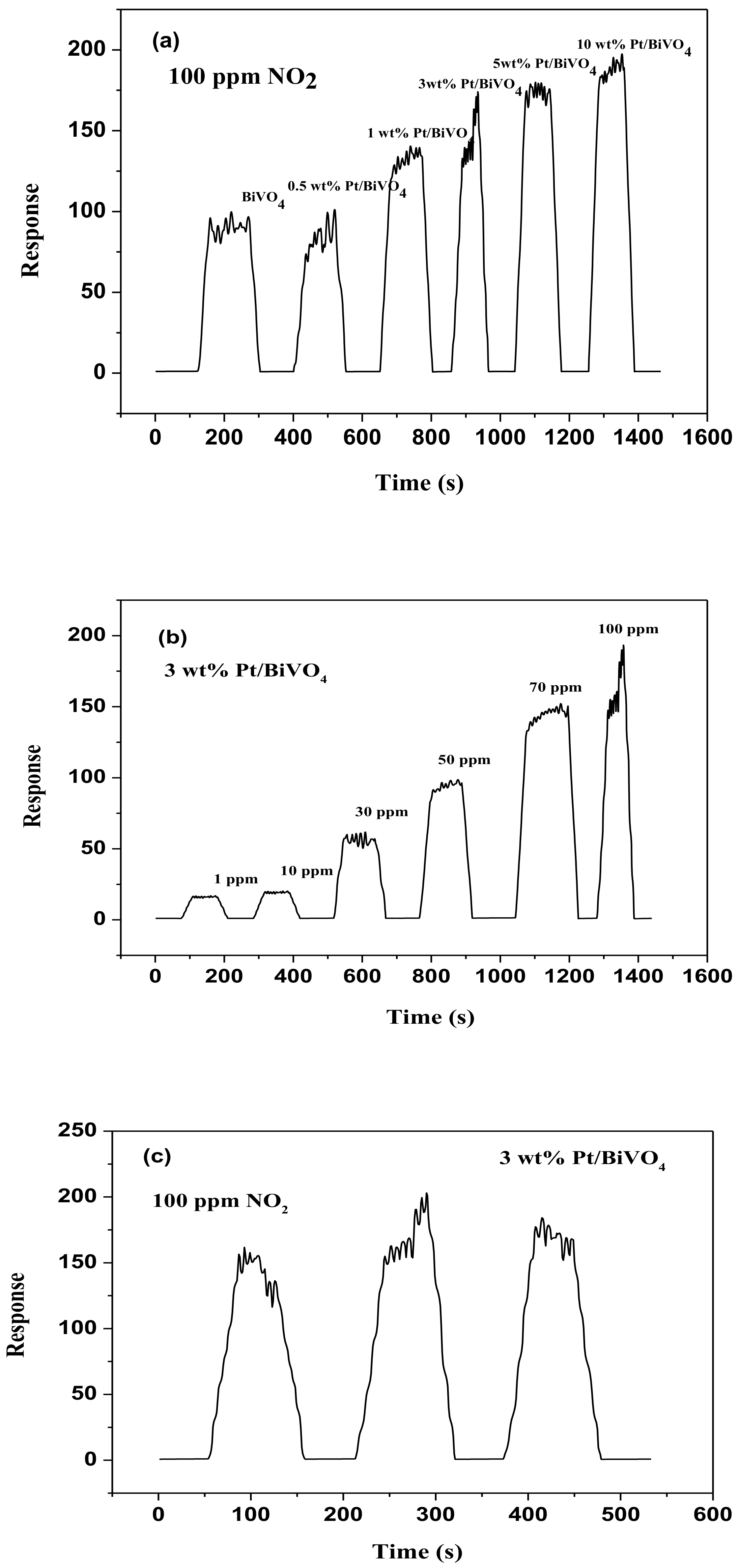
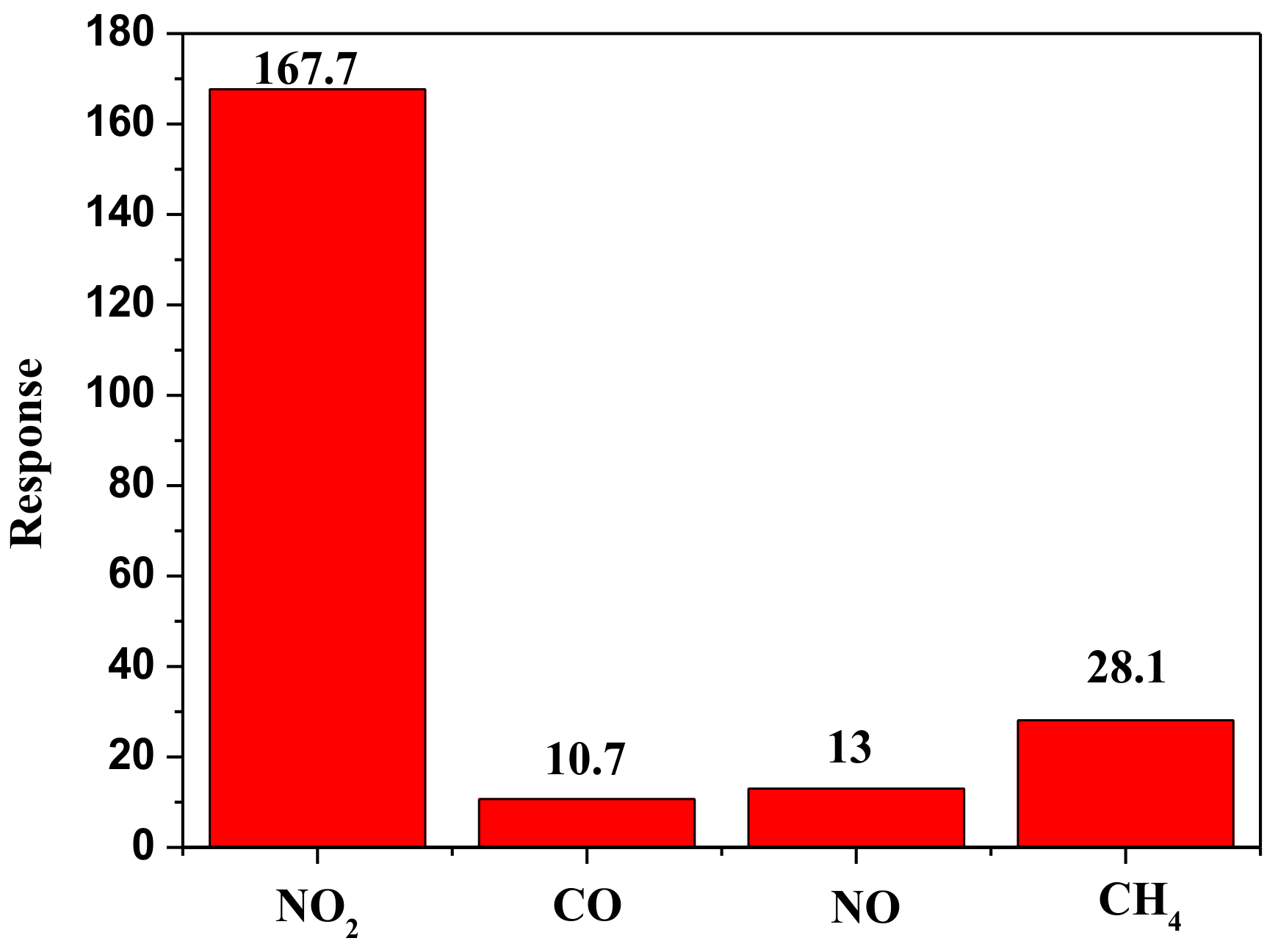


| Sensing Material | Response Time (T90, s) | Recovery Time (Tr90, s) | Response (100 ppm) | Pt Crystalline Size (by XRD) (nm), hkl, 111 | Bi Crystalline Size BiVO4 (by XRD) (nm), hkl | Linearity (R2) | |
|---|---|---|---|---|---|---|---|
| (051) | (161) | ||||||
| BiVO4 0.5 wt.% Pt/BiVO4 1 wt.% Pt/BiVO4 3 wt.% Pt/BiVO4 5 wt.% Pt/BiVO4 10 wt.% Pt/BiVO4 | 72 79 64 12 95 43 | 44 24 51 35 102 67 | 91.3 99.2 143.5 167.7 173.9 181.4 | - 10.1 10.6 12.1 12.9 16.3 | 24.8 24.2 25.2 25.5 25.8 24.6 | 26.5 25.8 27.7 27.7 28.2 27.4 | 0.983 0.950 0.982 0.992 0.980 0.928 |
| Sensing Material | Response (Rg/Ra or Ra/Rg) | NO2 (ppm) | Temperature (°C) | References |
|---|---|---|---|---|
| Pt-SnO2 α-Fe2O3/BiVO4 BiVO4/Cu2O BiVO4/Cu2O/rGO rGO-NiO-BiVO4 Pt/WO3 | 1.3 7.8 4.2 8.1 8.1 11.24 | 30 2 4 1 2 1 | 50 110 60 60 60 150 | [41] [10] [34] [9] [7] [35] |
| Pt/BiVO4 | 167.7 | 100 | 25 | This work |
Publisher’s Note: MDPI stays neutral with regard to jurisdictional claims in published maps and institutional affiliations. |
© 2021 by the authors. Licensee MDPI, Basel, Switzerland. This article is an open access article distributed under the terms and conditions of the Creative Commons Attribution (CC BY) license (https://creativecommons.org/licenses/by/4.0/).
Share and Cite
Lin, W.-D.; Lin, S.-Y.; Chavali, M. Improvement in NO2 Gas Sensing Properties of Semiconductor-Type Sensors by Loading Pt into BiVO4 Nanocomposites at Room Temperature. Materials 2021, 14, 5913. https://doi.org/10.3390/ma14205913
Lin W-D, Lin S-Y, Chavali M. Improvement in NO2 Gas Sensing Properties of Semiconductor-Type Sensors by Loading Pt into BiVO4 Nanocomposites at Room Temperature. Materials. 2021; 14(20):5913. https://doi.org/10.3390/ma14205913
Chicago/Turabian StyleLin, Wang-De, Shu-Yun Lin, and Murthy Chavali. 2021. "Improvement in NO2 Gas Sensing Properties of Semiconductor-Type Sensors by Loading Pt into BiVO4 Nanocomposites at Room Temperature" Materials 14, no. 20: 5913. https://doi.org/10.3390/ma14205913
APA StyleLin, W.-D., Lin, S.-Y., & Chavali, M. (2021). Improvement in NO2 Gas Sensing Properties of Semiconductor-Type Sensors by Loading Pt into BiVO4 Nanocomposites at Room Temperature. Materials, 14(20), 5913. https://doi.org/10.3390/ma14205913






